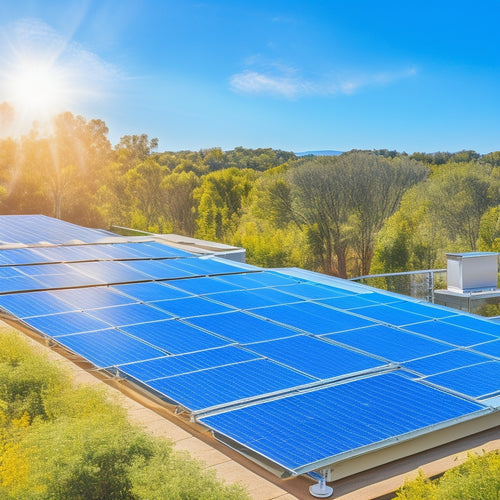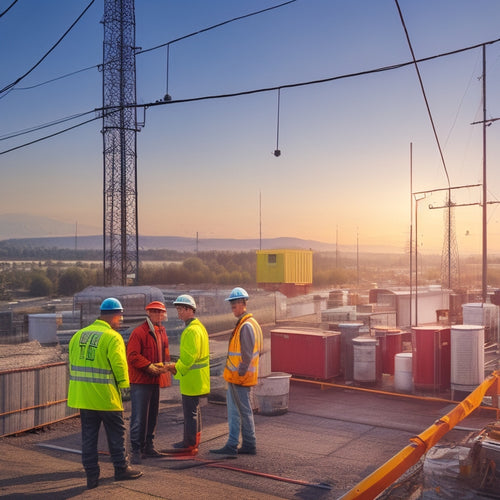
Reliable Solar Panels
Share
You can opt for high-efficiency solar panels with energy conversion rates of up to 22%, which guarantee maximum ROI and reduce your reliance on the grid. These reliable panels are designed for durability, with advanced manufacturing techniques and silicon utilization driving efficient energy conversion. They maintain consistent output in various environmental conditions, and with extended warranty options, you're protected for the long haul. By considering factors like roof space, orientation, and temperature coefficient rates, you can maximize energy production and independence. Now, get ready to utilize the full potential of solar energy by exploring the latest advancements in technology and design.
The Essentials
- Modern photovoltaic cells achieve energy conversion rates up to 22% for efficient energy harvesting and maximum ROI.
- High-efficiency solar panels maintain consistent output in various environmental conditions, ensuring reliable energy production.
- Extended warranty options provide protection for investment longevity, with high-efficiency brands like SunPower offering long-lasting solar panels.
- Advanced shade management strategies and enhanced bypass diode design minimize shade impact on solar panel performance and reduce power loss.
- Lower temperature coefficient rates ensure efficient energy harvesting in hot climates and heatwaves, maintaining consistent energy output throughout the year.
Higher Energy Conversion Rate
When you invest in reliable solar panels, you expect efficient energy harvesting to maximize your return on investment. A higher energy conversion rate guarantees you get the most out of your solar panel system, resulting in maximum power output.
Efficient Energy Harvesting
Your solar panel's photovoltaic cells are the workhorses behind efficient energy collection, boasting higher energy conversion rates that maximize your renewable energy output. These cells are the backbone of your solar technology, converting sunlight into electrical energy with extraordinary precision.
With advanced manufacturing techniques, modern photovoltaic cells can achieve energy conversion rates of up to 22%, considerably higher than their predecessors. This means you can generate more power from the same amount of sunlight, reducing your reliance on the grid and taking a considerable step towards energy independence. In fact, grid parity is now a reality, making solar energy a competitive option with traditional fossil fuels.
Additionally, the use of silicon in photovoltaic cells has been instrumental in driving this efficiency, allowing for more effective energy collection.
Efficient energy collection is critical to revealing the full potential of solar power. By optimizing energy conversion rates, you can reduce the number of panels required to meet your energy needs, saving you space and money.
Furthermore, high-efficiency solar panels can operate effectively in a wide range of environmental conditions, ensuring a consistent energy output even on cloudy or hot days. By leveraging the power of the sun with efficient energy collection, you can break free from the constraints of traditional energy sources and enjoy the freedom and flexibility that comes with renewable energy.
Maximum Power Output
By focusing on maximum power output, you can access the full potential of your solar panel system, translating to higher energy conversion rates and increased energy independence.
This means you'll be able to generate more electricity from the same amount of sunlight, reducing your reliance on the grid and saving you money on your energy bills.
By leveraging advanced technology and user-friendly configurations, you can simplify the installation process and maximize energy conversion rates Renewable Energy Enhancement.
Additionally, a well-designed Solar Array can address common problems such as high upfront costs and inefficient energy conversion.
To achieve peak performance, you'll want to verify your solar panels are operating at their highest level. This involves monitoring their output regularly and making adjustments as needed.
You should also consider investing in energy storage solutions, such as batteries, to store excess energy generated during the day for use at night or during power outages.
Longer Lifespan Guaranteed
You want solar panels that can withstand harsh weather conditions, and rightly so.
That's why reliable solar panels are designed to be durable and long-lasting, even in extreme temperatures, heavy rain, or intense sunlight.
With a focus on ideal energy efficiency, top-rated brands like SunPower offer high-efficiency solar panels built to last.
With extended warranty options, you can have peace of mind knowing that your investment is protected for years to come.
Durability in Harsh Weather
Most solar panels are designed to withstand harsh weather conditions, but only a few can guarantee a longer lifespan despite being exposed to extreme temperatures, heavy rainfall, and intense sunlight.
You want a solar panel that can stand the test of time and weather, ensuring a consistent energy output despite the environmental challenges.
When it comes to durability in harsh weather, you should look for solar panels with exceptional weather resistance.
This means the panels should be able to withstand extreme temperatures, from scorching heat to freezing cold, without compromising their performance.
Heavy rainfall and hailstorms shouldn't affect their efficiency, and intense sunlight shouldn't cause them to degrade quickly.
Extended Warranty Options
The manufacturer's warranty serves as a safeguard, guaranteeing a minimum lifespan for your solar panels. However, you may want to contemplate extended warranty options to guarantee your investment is protected for a longer period. These options typically provide additional years of warranty coverage, giving you peace of mind and protection against unexpected repair or replacement costs.
| Warranty Terms | Service Coverage |
|---|---|
| Standard Warranty (10 years) | Parts and labor costs for repairs or replacements |
| Extended Warranty (15 years) | Parts and labor costs for repairs or replacements, plus priority customer support |
| Premium Warranty (20 years) | Parts and labor costs for repairs or replacements, plus priority customer support and on-site service |
| All-Encompassing Warranty (25 years) | Parts and labor costs for repairs or replacements, plus priority customer support, on-site service, and system monitoring |
When choosing an extended warranty option, reflect on the warranty terms and service coverage that best fit your needs. Review the terms carefully to confirm you understand what is covered and for how long. With an extended warranty, you can enjoy your solar panels with confidence, knowing you're protected against unexpected expenses.
Enhanced Bypass Diode Design
You'll benefit from enhanced bypass diode design in reliable solar panels, which greatly improves diode efficiency and reduces power loss.
This means you'll get more energy output even when some panels are shaded or partially obstructed, thanks to enhanced shade tolerance.
For instance, during off-grid nights, this design guarantees a steady power supply.
Furthermore, it's crucial to evaluate a thorough solar battery storage system to store excess energy generated during the day.
Improved Diode Efficiency
By optimizing the bypass diode design, solar panels can considerably reduce energy losses, particularly in partial shading conditions. You can benefit from this improvement in your solar panel's overall efficiency.
The bypass diode's primary function is to protect the solar panel from overheating and hot spots caused by shading. When you upgrade to an enhanced bypass diode design, you'll experience reduced energy losses and increased power output.
The key to achieving improved diode efficiency lies in the selection of high-quality diode materials and advanced manufacturing processes. By using premium materials, you can minimize voltage drops and reduce heat generation.
Additionally, innovative manufacturing processes enable the production of diodes with lower forward voltage and higher reverse resistance. These advancements allow for faster and more efficient switching, resulting in reduced energy losses and increased overall efficiency.
With an optimized bypass diode design, you can enjoy a more reliable and efficient solar panel that generates more power and lasts longer.
Enhanced Shade Tolerance
Upgrade your solar panel's performance with enhanced shade tolerance, made possible by an innovative bypass diode design.
This state-of-the-art technology enables your solar panels to maintain peak energy production even when partially shaded. By incorporating advanced shade management strategies, you can minimize the impact of shade on your system's performance.
The enhanced bypass diode design allows your solar panels to operate at maximum efficiency, even when clouds or trees cast shadows on the panel.
This results in improved performance under clouds, ensuring you generate more power throughout the day.
With this advanced technology, you can enjoy increased energy independence and reduced reliance on the grid.
Check Your Roof Size
You'll need to assess your roof's space availability to determine how many solar panels can fit, considering factors like skylights, vents, and obstructions.
Additionally, you should evaluate your roof's orientation, as an ideal angle and direction (typically south-facing) can greatly impact energy production.
Many homeowners opt for off-grid energy solutions, which allow for greater flexibility regarding panel placement and energy storage.
Roof Space Availability
How much space do you have available on your roof for solar panels? This is an important question to answer when considering installing solar panels. The amount of available roof space will directly impact the number of solar panels you can install, which in turn affects the amount of electricity you can generate.
Roof design considerations play a significant role in determining the available space. For instance, a roof with multiple skylights, vents, or chimneys will have less available space than a roof with a simple design. Additionally, the size and shape of your roof will also impact the available space.
| Roof Size (sq. ft) | Number of Panels | Estimated Energy Output (kWh/month) |
|---|---|---|
| 1,000-1,500 | 5-7 | 500-700 |
| 1,500-2,500 | 7-10 | 700-1,000 |
| 2,500-3,500 | 10-14 | 1,000-1,400 |
Optimizing panel layout is vital to maximize energy output. A well-designed layout can increase energy production by up to 20%. By carefully evaluating your roof space availability and optimizing panel layout, you can generate the most energy possible and enjoy the freedom that comes with relying on renewable energy.
Optimal Roof Orientation
Determining the ideal roof orientation is essential for maximizing energy output from your solar panels. As you assess your roof's suitability for solar panels, consider the roof angle and direction.
In the northern hemisphere, a south-facing roof with an angle between 30° and 40° is ideal for solar panel placement. This orientation allows your solar panels to capture the most sunlight throughout the year, resulting in peak energy production.
However, if your roof doesn't face directly south, don't worry. East- and west-facing roofs can still generate significant energy, albeit slightly less than south-facing ones. Avoid north-facing roofs, as they receive minimal sunlight.
When it comes to roof angle considerations, a steeper angle can lead to more energy production during winter months, while a shallower angle is more suitable for summer.
Lower Temperature Coefficient Rate
You're likely aware that high temperatures can reduce your solar panel's energy output.
A lower temperature coefficient rate guarantees that your panels will maintain their efficiency even in hot climates or during heatwaves.
This results in more efficient energy harvesting, which translates to more power for your home or business.
Efficient Energy Harvesting
Solar panels with a lower temperature coefficient rate enable efficient energy harvesting by minimizing the impact of rising temperatures on their performance.
You benefit from a consistent energy output, even in hot climates or during peak summer months. This means you can rely on your solar panels to generate power when you need it most.
Advanced solar cell technology plays an essential role in efficient energy harvesting.
By optimizing the design and materials used in solar cells, manufacturers can reduce the temperature coefficient rate, resulting in a more stable energy output.
This technology also allows for better energy storage solutions, ensuring that excess energy generated during the day can be stored and used during periods of low sunlight or at night.
With efficient energy harvesting, you're not limited by the constraints of traditional energy sources.
You have the freedom to generate your own clean energy, reducing your reliance on the grid and minimizing your carbon footprint.
Frequently Asked Questions
Are Solar Panels Affected by Shade From Nearby Objects or Trees?
When you install solar panels, you'll find that shade from nearby objects or trees can greatly impact their performance, reducing solar efficiency by up to 20% - so, you'll want to strategically position them to minimize shade.
Can I Install Solar Panels on a Metal or Asphalt Roof?
You're right to question if solar panels can be installed on a metal or asphalt roof - and the answer is yes! You'll just need to take into account installation factors, like roof type compatibility, to guarantee a secure and efficient setup that gives you the freedom to utilize the sun's power.
Do Solar Panels Generate Electricity During a Power Outage?
During a power outage, you won't generate electricity with traditional net metering, but you can with battery storage options, allowing you to utilize solar power independently and stay energized when the grid goes dark.
How Often Should I Clean My Solar Panels for Optimal Performance?
Imagine a 15% energy loss due to dirty panels, like in Arizona's dust-prone climate. You should clean your solar panels every 6-12 months to maintain peak performance, as infrequent cleaning can lead to a significant performance impact.
Are Solar Panels Resistant to Hail, Wind, and Extreme Weather?
You're wondering if solar panels can withstand harsh conditions. Typically, they're designed to resist hail damage up to 1 inch in diameter and extreme weather like 140 mph winds, giving you freedom from energy worries even in turbulent climates.
Final Thoughts
As you consider investing in reliable solar panels, remember that every detail counts. With a higher energy conversion rate, longer lifespan, and enhanced bypass diode design, you'll maximize your energy output. Plus, lower temperature coefficient rates mean your panels will perform better even in scorching heat. Did you know that a single solar panel can power a refrigerator for an entire year? By choosing reliable solar panels, you'll be utilizing the power of the sun to fuel your daily life.
Related Posts
-

Top Eco-Friendly Camping Equipment for a Sustainable Adventure
When you're camping with the planet in mind, opt for eco-friendly gear like tents made from recycled materials and bi...
-

What Types of Solar Energy Devices Are Available
You'll find several types of solar energy devices available today, each customized to different energy needs. Photovo...
-

Smart Grid Technology Implementation Challenges
You'll encounter several challenges when implementing smart grid technology, particularly in cost management, scalabi...


